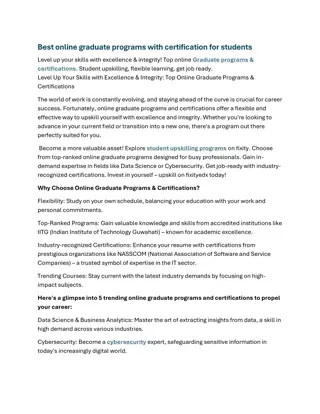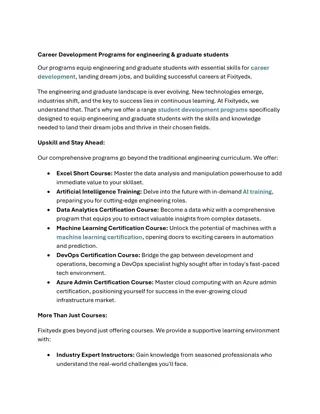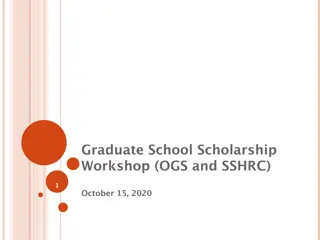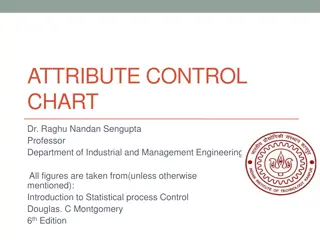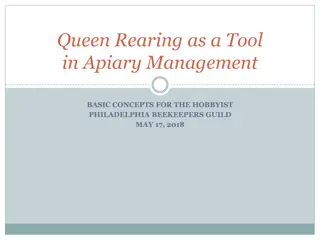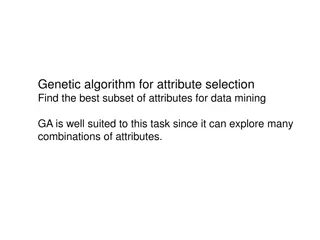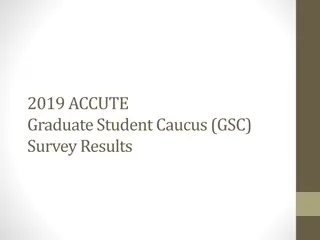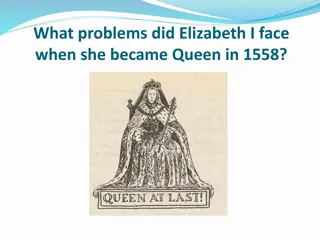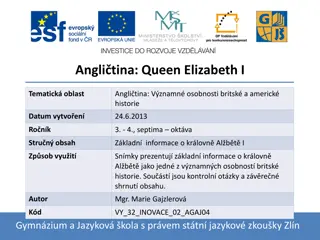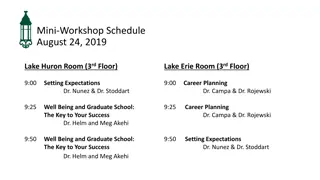Engineering Graduate Attribute Development Workshop at Queen's University
This workshop, led by Brian Frank, Director of Program Development at the Faculty of Engineering and Applied Science, focused on applying assessment principles to CEAB graduate attribute requirements and planning processes for program improvement. The session outcomes included using tools, technology, and terminology to inform program development. Discussions covered administrative issues and the importance of assessing program outcomes. The event highlighted the significance of outcomes-based assessment for demonstrating students' capabilities in the context of accreditation bodies like the Washington Accord.
Download Presentation

Please find below an Image/Link to download the presentation.
The content on the website is provided AS IS for your information and personal use only. It may not be sold, licensed, or shared on other websites without obtaining consent from the author. Download presentation by click this link. If you encounter any issues during the download, it is possible that the publisher has removed the file from their server.
E N D
Presentation Transcript
Graduate Attribute Assessment Workshop Brian Frank Director (Program Development) Faculty of Engineering and Applied Science Queen's University February 4, 2011 Please sit at tables with people from your department if possible. 1 Engineering Graduate Attribute Development (EGAD) Project
Session outcomes 1. Apply accepted assessment principles to CEAB graduate attribute requirements 2. Plan a process to generate data that can inform program improvement Be able to use: Tools Technology Terminology 2 Engineering Graduate Attribute Development (EGAD) Project
Administrative issues Questions/issues/ discussion? Ask! Paper Resources being added to http://engineering.queensu.ca/egad Summary handout for reference (terminology, process) Active workshop - feel free to ask questions or comment throughout 3 Engineering Graduate Attribute Development (EGAD) Project
Perspective: Sec 3.1 of CEAB Procedures The institution must demonstrate that the graduates of a program possess the attributes under the following headings... There must be processes in place that demonstrate that program outcomes are being assessed in the context of these attributes, and that the results are applied to the further development of the program.
Background Accreditation bodies in most industrialized countries use outcomes-based assessment to demonstrate their students' capabilities. Washington Accord: allows substantial equivalency of graduates from Australia, Canada, Hong Kong, Republic of Ireland, New Zealand, South Africa, United Kingdom, and United States, Japan, Singapore,Korea, and Chinese Taipei Discussions by CEAB and National Council of Deans of Engineering and Applied Science (NCDEAS) led to graduate attribute expectations in 2008
National Response NCDEAS set up pilot projects running at 6 universities (Dalhousie, Guelph, UBC, Calgary, Toronto, Queen s) Representatives have run workshops at NCDEAS, Queen's, Toronto, Dalhousie, UBC, RMC, and CEEA 2010 Conference Engineering Graduate Attribute Development (EGAD) project sponsored by NCDEAS formed by representatives from those schools, started Jan 2011
Graduate attribute assessment Outcomes assessment is used to answer questions like: What can students do? How does their performance compare to our stated expectations? It identifies gaps between our perceptions of what we teach and what knowledge, skills, and attitudes students develop program-wide.
Inputs and Outcomes Outcomes Inputs Demonstrated abilities (cognitive, skills, attitudes) Student pre-university background Faculty education, professional status Ongoing faculty development Class sizes Content Campus resources Contact hours Laboratory equipment Support services 8 Engineering Graduate Attribute Development (EGAD) Project
Outcomes assessment widely used Common in the Canadian primary, secondary, and community college educational systems National recommendations from provincial Ministers of Education, now required for all Ontario post-secondary programs: Undergraduate Degree- Level Expectations (OCAV UDLEs) Depth and Breadth of Knowledge Knowledge of Methodologies Application of Knowledge Communication Skills Awareness of Limits of Knowledge Autonomy and Professional Capacity
Good news: Most programs probably already have people doing this on a small scale: Some instructors already use course learning outcomes Design course instructors often assess design, communications, teaming skills Rubrics are becoming common for assessing non- analytical outcomes Can identify innovators and key instructors (e.g. project-based design courses, communications, economics)
Setting up a process (without overwhelming faculty and irritating staff)
CEAB graduate attributes (Sec 3.1) Knowledge base Design Problem analysis Individual and team work Communication skills Investigation Professionalism Use of engineering tools Impact on society and environment Ethics and equity Engineering science Economics and project management Laboratory Lifelong learning Project/experiential 12 Engineering Graduate Attribute Development (EGAD) Project
Questions for programs: What are your program's specific and measurable expectations ? How will you measure the students against specific expectations? Given requirements: Assess in 12 broad areas (graduate attributes), and create a process for program improvement. Where to measure the expectations (courses, internships, extra-curriculars...)? Processes in place for analyzing data and using it for improvement? 13 Engineering Graduate Attribute Development (EGAD) Project
Example of comprehensive curriculum design overview by P. Wolf at U Guelph From P. Wolf, New Directions for Teaching and Learning, Volume 2007, Issue 112 (p 15-20). Used with permission. Engineering Graduate Attribute Development (EGAD) Project 14
CEAB GA assessment instructions (2010) Describe the processes that are being or are planned to be used. This must include: a) a set of indicators that describe specific abilities expected of students to demonstrate each attribute b) where attributes are developed and assessed within the program c) how the indicators were or will be assessed. This could be based on assessment tools that include, but are not limited to, reports, oral presentations, d) evaluation of the data collected including analysis of student performance relative to program expectations e) discussion of how the results will be used to further develop the program f) a description of the ongoing process used by the program to assess and develop the program as described in (a)-(e) above Engineering Graduate Attribute Development (EGAD) Project 15
Course development process Identify course objectives and content Create specific outcomes for each class Map to experiences (lectures, projects, labs, etc.) Course improvement Student input Identify appropriate tools to assess (reports, simulation, tests,...) Analyze and evaluate data Course changes/ Measure 16 Engineering Graduate Attribute Development (EGAD) Project
Program-wide assessment process flow Identify major objectives (including graduate attributes) Create Indicators Program improvement Map to courses/ experiences Stakeholder input Identify appropriate tools to assess (reports, simulation, tests,...) Analyze and evaluate data Course changes/ Measure 17 Engineering Graduate Attribute Development (EGAD) Project
Assessment principles (adapted from ABET) Assessment works best when the program has clear objectives. Assessment requires attention to both outcomes and program. Assessment should be periodic, not episodic Assessment should be part of instruction
Program-wide assessment process flow Identify major objectives (including graduate attributes) Create Indicators Program improvement Map to courses/ experiences Stakeholder input Identify appropriate tools to assess (reports, simulation, tests,...) Analyze and evaluate data Course changes/ Measure 19 Engineering Graduate Attribute Development (EGAD) Project
Creating Program objectives CEAB graduate attributes Strategic plans Advisory boards Major employers of graduates Input from stakeholders Focus groups, surveys SWOT (strengths, weaknesses, opportunities, threats) analysis What do you want your program to be known for?
Program-wide assessment process flow Identify major objectives (including graduate attributes) Create Indicators Program improvement Map to courses/ experiences Stakeholder input Identify appropriate tools to assess (reports, simulation, tests,...) Analyze and evaluate data Course changes/ Measure 21 Engineering Graduate Attribute Development (EGAD) Project
Why performance indicators? Lifelong learning An ability to identify and address their own educational needs in a changing world in ways sufficient to maintain their competence and to allow them to contribute to the advancement of knowledge Can this be directly measured? Would multiple assessors be consistent? How meaningful would the assessment be? Probably not, so more specific measurable indicators are needed. This allows the program to decide what is important 22 Engineering Graduate Attribute Development (EGAD) Project
Indicators: examples Lifelong learning Graduate attribute An ability to identify and address their own educational needs in a changing world in ways sufficient to maintain their competence and to allow them to contribute to the advancement of knowledge The student: Critically evaluates information for authority, currency, and objectivity Identify gap in knowledge and develop a plan to address Indicators Uses information ethically and legally to accomplish a specific purpose Describes the types of literature of their field and how it is produced 23 Engineering Graduate Attribute Development (EGAD) Project
Establishing Indicators What specific things should students demonstrate? What do they need to be able to do? Are they measurable and meaningful? Can involve cognitive (recalling, analyzing, creating), attitudes, skills Level of expectation ( describes , compares , applies , creates , etc.) Content area Critically evaluates information for authority, currency, and objectivity
Indicators A well-written indicator includes: what students will do the level of complexity at which they will do it the conditions under which the learning will be demonstrated Engineering Graduate Attribute Development (EGAD) Project 25
Indicators Examples: knowledge base for engineering (mathematics) Critically select* and apply* computational formula to solve novelproblems Examples: Design Generates*original concepts and adapts* existing ones to offer diverse, viable solutions that address the problem definition Evaluates* the validity and reliability of models against specifications and the criteria established by a client Engineering Graduate Attribute Development (EGAD) Project 26
Problematic criteria What does the author mean? Students can state the laws? Plug numbers into equations? Apply laws to solve conceptual problems? ... Content area Learns static physics principles including Newtonian laws for linear motion 27 Engineering Graduate Attribute Development (EGAD) Project
Taxonomy Creating (design, construct, generate ideas) Evaluating (critique, judge, justify decision) Analyzing (compare, organize, differentiate) Applying (use in new situation) Understanding (explain, summarize, infer) Remembering (list, describe, name) Anderson, L. W. and David R. Krathwohl, D. R., et al (Eds..) (2001) A Taxonomy for Learning, Teaching, and Assessing: A Revision of Bloom's Taxonomy of Educational Objectives. Allyn & Bacon. Boston, MA (Pearson Education Group 28 Engineering Graduate Attribute Development (EGAD) Project
Verbs for cognitive skills Define Interpret Analyze List Compare Hypothesize State Contrast Evaluate Recall Solve Justify Identify Estimate Develop Recognize Explain Create Calculate Classify Extrapolate Label Modify Design Locate Integrate Critique Higher order skills Engineering Graduate Attribute Development (EGAD) Project 29
Outcomes at Blooms Levels (Romkey, McCahan): Knowing: Define the concepts of engineering stress and engineering strain. Understanding: Explain Hooke s Law in your own words and describe the conditions under which it is applicable. Applying: Utilize Poisson s Ratio to calculate lateral strain given a longitudinal loading situation. Analysing: Discuss the specific characteristics of the microstructure that render the stress-strain behaviour of a polymeric material as brittle, plastic, or elastic. Synthesizing: Investigate recyclability/disposability issues relative to (a) metals, (b) glass, (c) polymers, and (d) composites. Creating: Argue the economic viability of the green design philosophy of product design. 30 30 Engineering Graduate Attribute Development (EGAD) Project
Consider these indicators Students will learn concepts about linear motion. Students will describe concepts including force, power, energy, and momentum. Student will work effectively in teams. 31 Engineering Graduate Attribute Development (EGAD) Project
Defining Indicators for your Program (10 min) In groups of 2-4: 1. Select a graduate attribute your department hasn t already considered (teamwork or economics?) 2. Independently create some indicators for that attribute that reflect your program objectives 3. Discuss indicators at your table. Are they measurable? Are they meaningful? Would the assessment of them be consistent from one rater to another?
Follow-up to identifying Indicators Any points for discussion? Engineering Graduate Attribute Development (EGAD) Project 33
Resources on Indicators EC2000, ABET 2009 Note: Indicators may also be known as: Assessment criteria Performance criteria Outcomes Competencies Objectives UK-SPEC, Engineering Subject Centre Guide Engineers Australia CDIO Foundation Coalition Many linked at: UDLEs http://bit.ly/9OSODq (case sensitive, no zeros) Discipline-specific (Civil Engineering Body of Knowledge, IET criteria for electrical and computer engineering, etc.)
Program-wide assessment process flow Identify major objectives (including graduate attributes) Identify Indicators Program improvement Map to courses/ experiences Stakeholder input Identify appropriate tools to assess (reports, simulation, tests,...) Analyze and evaluate data Course changes/ Measure 35 Engineering Graduate Attribute Development (EGAD) Project
Indicator mapping First year courses Indicators Design Physics Calculus Chemistry etc. First year Design project course Middle years Assignment 1 used to assess: Assignment 2 used to assess: Team proposal used to assess: etc. Indicator 1 Indicator 2 Indicator 3 Indicator 1 Indicator 4 Indicator 5 Indicator 1 Indicator 6 Indicator 7 Graduating year 36 Engineering Graduate Attribute Development (EGAD) Project
Where can we assess students? Courses Co-ops/internships Co-curricular activities (competitive teams, service learning, etc.) Exit or alumni surveys/interviews ...
Assessment Mapping Mapping process focuses on where students should be assessed, not on every course where material is taught In a typical program the courses involved in assessing students are a small subset of courses. This might include a few courses from areas including: Engineering science Laboratory Complementary studies Project/experiential based
Two approaches to mapping Attributes to courses Courses to attributes We know what we want the program to look like how well do the attributes line up with our curriculum? Let s do a survey of our instructors, and determine experiences appropriate to developing and assessing attributes. Can do this one way or both ways 39 Engineering Graduate Attribute Development (EGAD) Project
Attributes to courses: Lifelong learning Developed Assessed Assessment tool(s) Indicator Critically evaluates procured information for authority, currency, and objectivity APSC-100 MECH-212 MECH-460 MECH-460 Project proposal report Oral exam MECH 490 Describes professional and academic societies in the discipline and how new knowledge enters discipline. APSC-100 MECH-270 MECH-333 MECH-490 MECH-490 Undergraduate thesis Identifies resources and professional associations that address own ongoing professional development. MECH-270 MECH-490 Co-op MECH-490 Pre-graduation interview Post co-op report Co-op 40 Engineering Graduate Attribute Development (EGAD) Project
Courses to attributes: First year Grad Attributes Supported Instructional Methods Assessment tool(s) Course Communication Individual & Team Work Professionalism Lifelong Learning Problem analysis (open- ended) Investigation Ethics and equity APSC-100 (Engineering practice) Design project Experimental project Model eliciting activity Project reports Oral presentations Peer evaluations Supervisor evaluation All rubric-based Knowledge Problem analysis (closed- ended) APSC-171 (Calculus I) Lecture, independent work Targeted question on final exam 41 Engineering Graduate Attribute Development (EGAD) Project
More comprehensive mapping table Developed in: Assessment Method Measured in: Time measured Assessment coordinator Indicator Evaluation ME113, EM213, ME213, ME235, ME333, ME412 Produces research information for the team Portfolios Peer Evaluations, Faculty Evaluations ME 213 ME412 ME 213 Even ME412 Odd Even Armaly Odd - Richards Curriculum Committee ME113, EM213, ME213, ME235, ME333, ME412 Demonstrates understanding of team roles when assigned Peer Evaluations, Faculty Evaluations ME 213 ME412 ME 213 Even ME412 Odd Even Armaly Odd - Richards Curriculum Committee ME113, EM213, ME213, ME235, ME333, ME412 Peer Evaluations, Faculty Evaluations Shares in the work of the team ME 213 ME412 ME 213 Even ME412 Odd Even Armaly Odd - Richards Curriculum Committee ME113, EM213, ME213, ME235, ME333, ME412 Demonstrates good listening skills Peer Evaluations, Faculty Evaluations ME213 ME412 ME 213 Even ME412 Odd Even Armaly Odd - Richards Curriculum Committee 42 Engineering Graduate Attribute Development (EGAD) Project
Curriculum mapping surveying U Guelph developing Currickit: Curriculum Mapping Software Online survey, completed by each instructor, to describe whether an attribute is developed, assessed, or both Software collects data and reports on attributes in the program U Calgary surveyed instructors to find out where attributes are Introduced, Developed, or Utilized (ITU) in courses
ITU Analysis: Introduced CEAB Graduate Attributes Introduced1 (Mechanical 1st Year 2nd Year 3rd Year 4th Year 10 9 8 Number of Courses 7 6 5 4 3 2 1 0 3.1.4 Design 3.1.3 Investigation 3.1.8 Professionalism 3.1.2 Problem Analysis 3.1.7 Communication skills 3.1.10 Ethics and equity 3.1.12 Life-long learning 3.1.5 Use of engineering tools 3.1.6 Individual and team work 3.1.1 Knowledge base for engineering 3.1.11 Economics and project management 3.1.9 Impact of eng on society & environment Source: B. Brennan, University of Calgary 44 Engineering Graduate Attribute Development (EGAD) Project
ITU Analysis: Taught Source: B. Brennan, University of Calgary 45 Engineering Graduate Attribute Development (EGAD) Project
ITU Analysis: Utilized Source: B. Brennan, University of Calgary 46 Engineering Graduate Attribute Development (EGAD) Project
Program-wide assessment process flow Identify major objectives (including graduate attributes) Identify indicators Program improvement Map to courses/ experiences Stakeholder input Identify appropriate tools to assess (reports, simulation, tests,...) Analyze and evaluate data Course changes/ Measure 47 Engineering Graduate Attribute Development (EGAD) Project
Assessment tools How to measure learning against specific expectations? Direct measures directly observable or measurable assessments of student learning E.g. Student exams, reports, oral examinations, portfolios, etc. Indirect measures opinion or self-reports of student learning or educational experiences E.g. grades, student surveys, faculty surveys, focus group data, graduation rates, reputation, etc.
Assessment tools Local written exam (e.g. question on final) External examiner (e.g. Reviewer on design projects) Standardized written exam (e.g. Force concept inventory) Oral exam (e.g. Design projects presentation) Performance appraisal (e.g. Lab skill assessment) Oral interviews Simulation Surveys and questionnaires (e.g. Emergency simulation) Behavioural observation (e.g. Team functioning) Focus group Portfolios Archival records (student maintained material addressing outcomes) (registrar's data, previous records, ...) 49 Engineering Graduate Attribute Development (EGAD) Project
Instructors: We do assess outcomes by grades How well does the program prepare students to solve open-ended problems? Student transcript Electric Circuits I Electromagnetics I Signals and Systems I Electronics I Electrical Engineering Laboratory Engineering Communications Engineering Economics ... Electrical Design Capstone 78 56 82 71 86 76 88 Are students prepared to continue learning independently after graduation? Do students consider the social and environmental implications of their work? 86 What can students do with knowledge (plug-and-chug vs. evaluate)? Course grades usually aggregate assessment of multiple objectives, and are indirect evidence for some expectations





